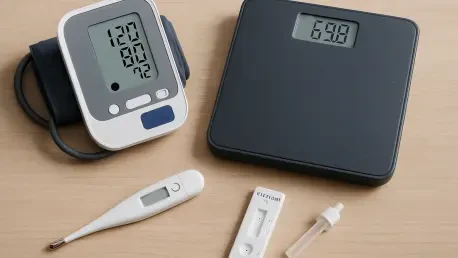Imagine a world where a simple device in your hand could alert you to a health issue before it becomes a crisis, empowering you to take control of your wellness without stepping into a doctor’s office. Self-screening tools are making this vision a reality, fundamentally changing the landscape of preventive healthcare by placing the power of early detection and monitoring directly into the hands of individuals. From portable blood pressure monitors to smartphone-connected diagnostic gadgets, these innovations are shifting the paradigm from reactive treatment to proactive prevention, enabling personalized health management at an unprecedented level.
This transformation extends far beyond personal empowerment, creating a ripple effect throughout the entire healthcare ecosystem. Hospitals, clinics, and insurers are adapting to a new reality where efficiency, cost savings, and data-driven insights are becoming the norm. In regions with strained medical resources, such as India, self-screening tools offer a lifeline, promising improved access and affordability. As these technologies gain traction, they’re not only enhancing health outcomes but also redefining how care is delivered and monetized, setting the stage for a future where prevention takes center stage.
Empowering the Modern Healthcare Consumer
Shifting to Proactive Health Management
The rise of self-screening tools marks a pivotal moment in healthcare, as individuals transition from passive patients to active participants in their well-being. Devices like glucose trackers, fertility kits, and heart rate monitors allow people to check vital health metrics in real time, often from the comfort of home. This ability to detect potential issues early fosters a sense of control and peace of mind, encouraging timely interventions before conditions escalate. Beyond personal benefits, this shift strengthens the bond between consumers and healthcare providers, as engaged individuals are more likely to follow through with medical advice and maintain consistent communication. Insurers, too, see advantages, with healthier policyholders translating to fewer claims and lower costs. This dynamic reflects a growing demand for convenience and transparency, positioning self-screening as a cornerstone of modern preventive care that aligns with the needs of today’s informed consumer.
Cultural Embrace of Personal Accountability
Alongside technological advancements, a profound cultural change is underway, with people increasingly viewing health as a personal responsibility rather than a distant concern. Self-screening tools cater to this mindset by offering speed and accessibility, allowing users to bypass long waits for appointments and gain immediate insights into their health status. This trend is reshaping expectations, as consumers seek solutions that fit seamlessly into busy lifestyles while providing clear, actionable information. The move toward prevention over cure is becoming a shared value, evident in the rising popularity of at-home diagnostics and digital health platforms. Such tools not only empower individuals to prioritize wellness but also reduce the burden on traditional healthcare settings by catching issues early. This cultural shift signals a broader acceptance of technology as a partner in health, fundamentally altering how society approaches long-term care and personal accountability.
Optimizing Healthcare Systems for Efficiency
Streamlining Operations Through Technology
Self-screening tools are proving to be a game-changer for healthcare systems grappling with resource constraints and high patient volumes. By enabling effective triaging, these devices help clinics and hospitals prioritize care for high-risk individuals, reducing unnecessary visits and easing pressure on emergency rooms. For instance, patients with chronic conditions can monitor their health at home, alerting providers only when readings indicate a problem, thus optimizing resource allocation. Hospitals are also adopting innovative retention strategies, such as integrating self-screening devices into post-discharge care plans, which maintain patient connections through continuous monitoring. This not only improves outcomes but also drives revenue through associated diagnostics and outpatient services. Studies suggest that digital triaging and remote tools could slash operational costs by 15-25%, offering a compelling financial incentive for widespread adoption in a cost-sensitive industry.
Financial Gains for Insurers and Providers
The financial implications of self-screening extend to insurers and healthcare providers, creating a mutually beneficial landscape. Early detection facilitated by these tools often prevents the progression of conditions to stages requiring expensive treatments, directly reducing costs for insurers who face fewer high-value claims. Providers, meanwhile, can manage chronic illnesses more effectively, minimizing hospital readmissions and enhancing patient satisfaction through tailored care plans. The integration of self-screening into healthcare models also supports a shift toward value-based care, where reimbursement is tied to outcomes rather than the volume of services rendered. This alignment of financial incentives encourages the adoption of preventive measures across the board, ensuring that both providers and insurers prioritize long-term health over short-term fixes. Together, these benefits highlight how self-screening is not just a clinical tool but a strategic asset for sustainable healthcare economics.
Leveraging Data for Precision and Prediction
Building Personalized Care with Data Insights
At the heart of the self-screening revolution lies a treasure trove of data, generated with every test and reading taken by users. This information enriches patient health records, creating detailed profiles that enable healthcare providers to design highly personalized treatment plans. Predictive care, powered by this data, allows for the identification of potential health risks before they manifest, paving the way for precision medicine that targets individual needs rather than relying on generalized approaches. The depth of insight offered by self-screening devices supports proactive interventions, ensuring that care is both timely and relevant. As healthcare moves toward a model where outcomes take precedence over volume, this data becomes a critical asset, guiding decisions that enhance patient well-being while optimizing resource use. The ability to anticipate and address health concerns with such accuracy marks a significant leap forward in preventive care strategies.
Enhancing Population Health and Underwriting Models
Beyond individual benefits, the data from self-screening tools offers profound value for broader health systems and insurers. Aggregated information provides a window into population health trends, helping public health officials and providers identify prevalent issues and allocate resources accordingly. Insurers, in turn, leverage these insights to refine underwriting models, crafting policies that better reflect real-world health risks and behaviors. This data-driven approach facilitates more accurate pricing and risk assessment, ultimately benefiting both policyholders and companies through fairer, more sustainable systems. Additionally, the focus on early intervention driven by such data reduces the incidence of costly late-stage treatments, aligning with the industry’s shift to value-based care. The ripple effect of these insights transforms how healthcare stakeholders plan and respond, ensuring that decisions are grounded in comprehensive, real-time evidence rather than outdated assumptions.
Unlocking New Business Horizons
Innovating Revenue Models with Diagnostics
Self-screening tools are opening up a wealth of opportunities for businesses within the healthcare sector, particularly through innovative revenue models. Subscription-based diagnostic kits for chronic conditions like diabetes or heart disease provide a steady stream of income while ensuring patients remain engaged with their care. Clinics and telehealth platforms are bundling these tools with virtual consultations, creating comprehensive care packages that meet consumer demand for integrated solutions. Many of these services qualify for reimbursement under preventive care and remote monitoring codes, further incentivizing adoption. This financial framework not only drives profitability but also positions businesses as leaders in a competitive market by offering value-driven, accessible health solutions. The ability to tap into recurring revenue through self-screening reflects a broader trend of aligning business growth with consumer health needs.
Creating Scalable, Patient-Focused Ecosystems
The scalability of self-screening tools is another key factor fueling business innovation, as companies design patient-centered ecosystems that integrate seamlessly into existing healthcare frameworks. Hospitals and clinics use these devices as entry points to digital care journeys, guiding patients from at-home testing to telehealth follow-ups and in-person visits when necessary. This continuous engagement model not only enhances patient loyalty but also creates multiple touchpoints for revenue generation through diagnostics, pharmacy services, and specialized care. By prioritizing user-friendly designs and interoperability with digital platforms, businesses ensure that these tools are accessible to a wide audience, driving adoption across diverse demographics. The result is a healthcare landscape where profitability and patient well-being go hand in hand, with self-screening acting as a catalyst for sustainable growth and innovation in an increasingly competitive industry.
Addressing Barriers to Widespread Adoption
Prioritizing Accessibility and Inclusivity
For the full potential of self-screening tools to be realized, accessibility must be a central focus, ensuring that these innovations reach beyond affluent or tech-savvy populations. Affordability remains a significant barrier, particularly in low-income regions where even basic diagnostic tools may be out of reach. Businesses can bridge this gap by offering tiered pricing models and partnering with public health initiatives to subsidize costs. Additionally, providing multilingual instructions and hybrid distribution channels—combining online platforms with offline networks—can expand access across geographic and cultural divides. Such efforts not only broaden market reach but also build societal trust, positioning companies as champions of equitable healthcare. Addressing these challenges head-on is essential to prevent self-screening from becoming a privilege of the few, ensuring that its benefits are felt by diverse communities worldwide.
Tackling Regulatory and Privacy Hurdles
Equally critical to the success of self-screening tools are the issues of regulatory compliance and data privacy, which must be navigated with precision to maintain credibility. Adhering to standards set by bodies like the FDA or ICMR is non-negotiable, as is ensuring that devices meet rigorous safety and accuracy benchmarks. Data privacy, governed by frameworks such as HIPAA, demands robust safeguards to protect sensitive health information from breaches or misuse. Companies must invest in secure systems and transparent practices to reassure users that their data is handled responsibly. Failure to address these concerns risks undermining public confidence and stalling adoption, no matter how innovative the technology. By proactively aligning with ethical and legal guidelines, businesses can foster an environment of trust, ensuring that self-screening tools contribute to a healthcare system that is both transformative and responsible.
Global and Local Imperatives for Preventive Care
Meeting India’s Healthcare Challenges
In a country like India, where a vast population and limited resources create immense pressure on healthcare infrastructure, self-screening tools emerge as a vital solution for sustainable care. These devices offer a path to better health outcomes by enabling early detection and reducing reliance on overburdened hospitals for routine monitoring. The preventive healthcare market in India is projected to grow at a compound annual growth rate of 22%, reaching ₹1.5 trillion by 2030, driven by increasing awareness and accessibility. Companies facilitating large-scale screening solutions are playing a crucial role, partnering with hospitals and corporations to integrate these tools seamlessly into existing systems. This scalability ensures that preventive care can address the unique needs of diverse regions, alleviating systemic strain while improving quality of life for millions. The urgency of this approach underscores self-screening as a necessity rather than an option in such contexts.
Capitalizing on Global Digital Health Growth
On a global scale, the momentum behind self-screening tools is equally striking, fueled by the rapid expansion of the digital health market, which is expected to exceed $660 billion in value. Self-diagnostic and remote monitoring technologies are at the forefront of this growth, reflecting a worldwide shift toward decentralized, consumer-driven healthcare models. Businesses that harness these tools are well-positioned to lead in an evolving landscape, capitalizing on the demand for innovative, accessible solutions that empower individuals. This trend transcends borders, with both developed and emerging markets recognizing the value of prevention over cure. The integration of self-screening into broader digital health strategies signals a fundamental change in how care is accessed and delivered, promising improved outcomes and efficiency on a massive scale. As this market continues to mature, the focus remains on balancing technological advancement with equitable distribution to maximize impact.
Paving the Way for a Preventive Future
Reflecting on Transformative Shifts
Looking back, the journey of self-screening tools reveals a profound transformation in how healthcare is approached, moving from a reactive stance to a preventive ethos that empowers individuals like never before. These innovations have reshaped patient-provider dynamics, as people take charge of their health with accessible, user-friendly devices that deliver real-time insights. Hospitals and insurers have adapted to this new reality, finding ways to enhance efficiency and reduce costs while embracing data as a cornerstone of care. Businesses, too, have seized the moment, crafting revenue models that align profitability with patient well-being. Challenges of equity and compliance have been tackled head-on by those committed to inclusivity, ensuring that the benefits of technology reach diverse populations. This era marks a turning point, where the adage of prevention over cure has become a lived reality across global and local healthcare landscapes.
Charting the Next Steps for Impact
As the legacy of self-screening tools continues to unfold, the focus must shift to actionable strategies that build on past achievements. Stakeholders across the healthcare spectrum should prioritize partnerships that enhance accessibility, ensuring that affordable solutions reach underserved communities through public and private collaboration. Investment in robust data security and regulatory frameworks will be critical to sustain trust and drive adoption in the years ahead. Businesses can explore integrating artificial intelligence with self-screening to refine predictive care, while policymakers might consider incentives for preventive health initiatives to accelerate systemic change. For regions like India, scaling localized solutions that address unique demographic challenges will remain a priority. By fostering innovation alongside ethical responsibility, the healthcare community can ensure that the promise of self-screening evolves into a lasting foundation for global wellness and equity.









